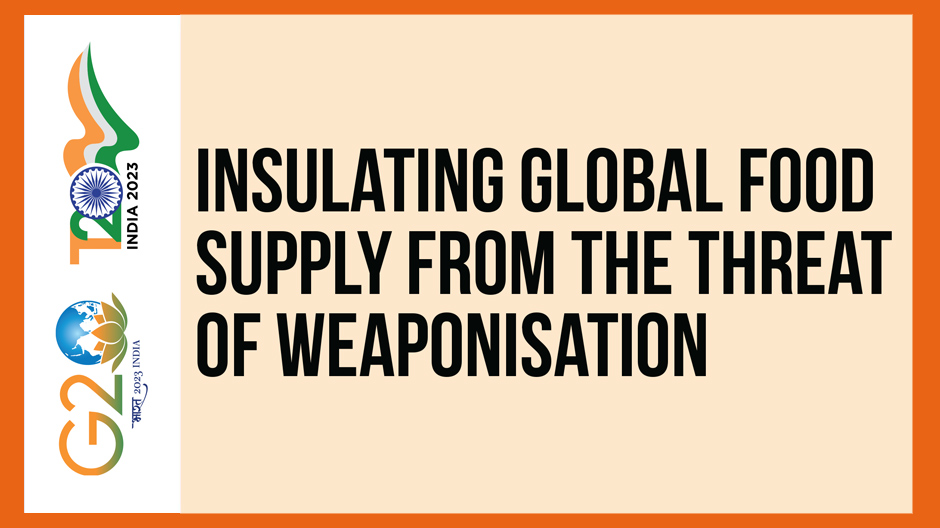Task Force 7: Towards Reformed Multilateralism—Transforming Global Institutions and Frameworks
The Russia-Ukraine war has led to a global food supply crunch due to port closures and the suspension of agricultural processing activities, which many have termed an act of food weaponisation. This has led to price surges in grains and fertilisers, exacerbating the challenges of food and nutrition security for the most vulnerable groups in developing countries. While the Additional Protocol to the Geneva Conventions delves into categorising military and civilian objects during a conflict, there is a lack of clarity on food due to its dual-use nature. Thus, there is a need for an amendment to restrict states from using granaries and agricultural lands as military objectives. Although the amendments might prevent future acts of food weaponisation, the current threat to food security remains. This policy brief recommends the utilisation of the existing Agricultural Market Information System infrastructure for monitoring food prices and enhancing market supervision, creating green corridors and free trade zones for agricultural goods, enabling food crop diversity, and establishing grain repositories, which are essential to complement the G20 Bali Declaration’s commitment to addressing food security.
1. The Challenge
The onset of COVID-19 resulted in increased food prices due to a panic-driven mass buying and hoarding of food, a hike in fuel prices due to the geopolitical and geoeconomic shock of the pandemic, and variability in the yield due to climate change. However, the Russian offensive in Ukraine that began in February 2022 amplified global food security challenges.[1] As both countries are identified as top exporters of food grains and oilseeds such as wheat, barley and sunflower, the war has significantly disrupted exports due to the destruction of infrastructure and production in Ukraine and multiple sanctions against Russia.[2] Additionally, the global food supply was drastically affected by Russia’s blocking of Black Sea ports.[3] On 17 April 2022, David Beasley, Director of the World Food Programme (WFP), suggested that food is being used as a weapon by Russia as part of its tactics in the conflict.[4]
While conflicts and war are generally known for large-scale destruction, the disruptions of essential goods such as food and water might prove to be more catastrophic than bombs, as the food supply shortages threaten the entire population and not just the combatants. Food security concerns during the war can be triggered by mass displacement of people, blocking humanitarian aid, contaminating food stocks, preventing harvesting, and the tactical crunch of food supply for favourable outcomes in negotiations.
These concerns regarding food being viewed as a military object were first addressed in the Additional Protocols to the Geneva Conventions of 12 August 1949. Article 48 of the Additional Protocol requires the signatories to distinguish between military and civilian objectives.[5] Further, Article 52(1) calls for protecting civilian objects against military attacks and operations.[6] However, under Article 52(2), there is a lack of clarity regarding the definition of civilian objects, as it primarily focuses on defining military objectives. It suggests that military objectives could contribute to military action by nature, location and purpose or if capturing or destroying such objects provides a military advantage. The interpretation of the articles poses a dilemma for the dual use of fundamental resources such as food that both civilians and the military use. According to Article 54, the parties engaged in a conflict are prohibited from attacking objects essential for the survival of civilian populations.[7] Nevertheless, food is considered a military objective if it is produced or prepared solely for the armed forces, codified in Article 54(3)(b) of the additional protocol.[8]
Weaponising food has been an old phenomenon in human history as various parties have sought to attack enemies psychologically.[9] One such instance was during the Civil War in the United States (US) when the Union soldiers were allowed to “starve” their enemies, as prescribed in Article 17 of the Lieber Code.[10] The civil war in South Sudan provides another example where the armed groups forced the farmers to stop cultivation and set the existing markets on fire.[11] According to its 2019 report, the WFP described the ongoing Yemen conflict as the “worst human-made disaster”, with an evident relationship between conflict and hunger.[12] The neighbouring states of Saudi Arabia and the United Arab Emirates (UAE) intervened in Yemen to restore the government deposed by the Houthis rebel group in 2014. As a part of the protracted conflict, their coalition blockaded Hodeida Port on the Red Sea, which is one of the primary entry points for food imports. This tactic forced more than 50 per cent of Yemen’s population to seek assistance for food.
While the destruction due to war jeopardises the food supply of the parties involved, the globalised world is vulnerable to a spill-over effect. The Russia-Ukraine conflict induced a decreased global food supply, leading to a steep increase in food prices (see Figure 1). Further, as per estimates by the Food and Agriculture Organization (FAO), the increased prices might increase undernourished people from 7.6 to 13.1 million, threatening food security, especially in developing countries.[13] However, the United Nations (UN)-led Black Sea Grain Initiative signed in July 2022 between the Russian Federation, Turkey and Ukraine, helped in resuming food and fertiliser exports from Ukraine, which reduced food prices (see Figure 1).[14]
Figure 1. Food Price Index (2017–2023)
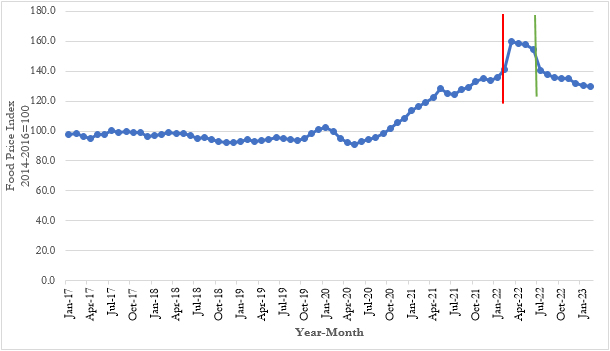
Source: FAO Food Price Index, Food and Agriculture Organization of the United Nations[15]
Figure 2. Fuel (energy) Price Index Monthly Price
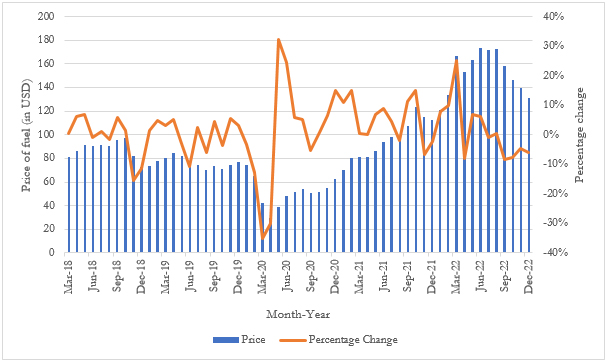
Source: IndexMundi[16]
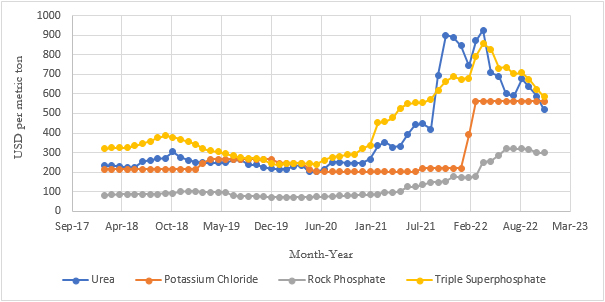
Source: IndexMundi[17]
Figure 4. Price of Wheat per Bushel
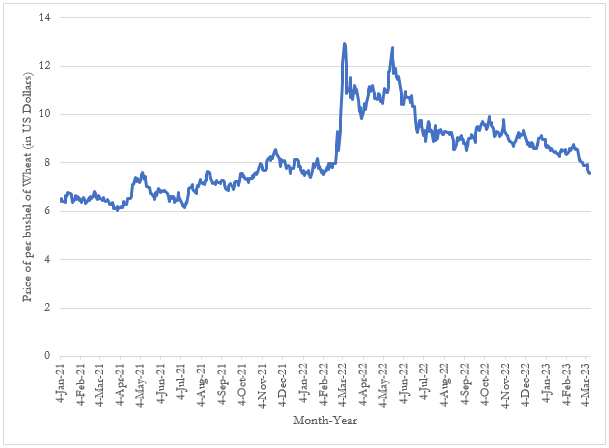
Source: Macrotrends Dataset[19]
2. The G20’s Role
As a collective of 20 developed and developing economies, the G20 possesses the capacity, experience, and expertise to play a crucial role in mitigating the ill effects of periodic shocks and price fluctuations induced by incidents like wars or pandemics. The group’s collective commitment to the Sustainable Development Goals (SDGs), particularly SDG-2, which aims to end hunger, improve nutrition and achieve food security, needs to be prioritised during negotiations, given the increasing weaponisation of food and its repercussions. It can act as a catalyst in facilitating mechanisms to achieve food security by fostering awareness and providing a platform for information sharing and promoting collaborative learning.
G20 summits have hosted the Agricultural Ministers Meetings, in which a wide range of issues was taken up and action plans were set to address them. The G20, in response to the 2007–08 food-price crisis, launched the Global Agriculture and Food Security Program (GAFSP) as a financing platform for improving food and nutrition security. The initiative has enabled the building of sustainable and resilient food systems, which raised farmer incomes, reduced food prices and generated employment.[20] Under the Turkish presidency, the G20 emphasised on improving food security and promoting sustainability of the food systems. As a testament to this commitment, it also released a standalone document dedicated to food.[21] During the German leadership in 2017, the emphasis was on achieving food security and water sustainability. The G20 Initiative for Rural Youth Employment was also launched at the 2017 summit to improve income and employment in food systems.[22] The G20, in its Matera Declaration, called for mobilising political, financial, policy and technical support for vulnerable groups such as smallholder farmers and women by investing in better food systems to achieve Zero Hunger in developing nations.[23] Further, it aimed to achieve these commitments by aligning its actions with World Trade Organization measures to ensure rules-based trade in agriculture for improving food security. Coordinated measures by G20 with other international and regional organisations, such as the FAO and the WFP, could be vital for its success in addressing food security concerns.
Building resilience in food supply is complex as geopolitical, geoeconomic, and environmental settings influence grain production and transportation. A resilient food supply chain should ensure the absorption of both predictable and unpredictable crises by enhancing its adaptive capacity. G20 programmes like AMIS, established to enhance market transparency and international policy cooperation, can help farmers by disseminating relevant information on global market conditions and formulating best practices through training.[24] This will also be critical in spreading knowledge and details of climate-related data that could help scale up resilience against climate-induced externalities.
During its presidency, India has to work with the previous (Indonesia) and the upcoming (Brazil and South Africa) presidents of the G20 for the continuity of practical measures and impactful actions. In the G20 Leaders Declaration and the joint statement of the Bali Summit, member states have committed to addressing the aggravation of food security concerns initially by the COVID-19 pandemic, followed by conflicts and tensions.[25] India must be responsible for safeguarding food supply chains from both acute and perennial challenges. By doing so, India can ensure the availability and accessibility of food, especially for least-developed economies. During COVID-19, amid the increased trade restrictions, India was able to avert food security problems by efficiently using its public distribution systems.[26] The experience and expertise India has gained through its food security policies can prove invaluable for other G20 countries. By learning from India’s practices, G20 nations can enhance their ability to establish sustainable food systems by implementing resilient production, storage and distribution methods for food grains.
As the world faces a food crisis, India has prioritised addressing the current supply disruption by promoting the adaptation of alternate food grains, such as millet. Being one of the largest producers of millet such as pearl millet, finger millet, barnyard millet, foxtail millet and others, India can lead the transition towards millet use as it intends through the International Year of Millet, declared by the UN General Assembly.[27] This process could integrate millets—primarily produced in arid regions—into global markets to reduce dependency on food grains like wheat and paddy.
There is a need for the G20 to recognise and acknowledge that the threat to food security affects not only humans but also animals and other organisms. The G20 Bali commitment towards implementing the One Health approach to tackle antimicrobial resistance (AMR) and creating a sustainable food system is imperative to ensure well-being for all.[28] The Lifestyle for Environment (LiFE) initiative by India aims to catalyse the previous commitments of the G20. The group, through its shared platform, can delegate its member states specific responsibilities for fostering food security with fewer barriers.
3. Recommendations to the G20
Crises like the COVID-19 pandemic and the Russia-Ukraine are wake-up calls for policymakers to strengthen the resilience of global food supply chains from being used as a weapon for military or political advantage. This policy brief proposes five recommendations to the G20 for consideration while formulating action plans on the issue.
Call for amendment in defining military objectives in Article 52 of the Additional Protocol
One of the primary challenges to be addressed for preventing the weaponisation of food is by proposing amendments to the universal definition of the military objective in Article 52: (General Protection of Civilian Objects) of the Additional Protocols of Geneva Conventions. A sub-clause could be added to demarcate food and water as essentials for the survival of civilians and insulate these crucial commodities from weaponisation. The G20 Agriculture Ministers Meeting is the best available platform to convey the importance of this amendment to the UN by highlighting the interlinkage between food and conflict. While the ratification of amendments might take time for all signatories, the urgency and importance of the situation must instil a collective action by global leaders at the earliest. While the primary objective is to bring an amendment to the article, it is crucial to concurrently develop other mechanisms that take into account the evolving nature of conflict and their impact on food supply.
Leveraging AMIS infrastructure for monitoring food prices and strengthening market supervision
AMIS, launched in 2011 by the G20 Ministers of Agriculture, has provided a platform for policy coordination with a primary focus on four grains: rice, wheat, soybeans and maize. The G20, under India’s leadership, can include other food grains, especially millet, under the ambit of the initiative, which has the potential to regulate and ensure a continued flow of food grains. A regular publication of country-specific monitoring of grain production by AMIS can ensure transparency in the global food market. Building efficient information and communications technology (ICT) tools that offer practical and fast access to information related to agriculture—from weather to market forecasts—could benefit farmers. If created by the G20 nations, such technologies can aid decision making on agricultural patterns and systems, pesticide use, and even the early detection of vulnerabilities.
Establishing a green corridor and free trade zones for agricultural goods
The G20 member countries can form a dedicated green corridor for transporting agricultural goods and with fewer roadblocks despite geopolitical and geoeconomic volatility. This can ensure a seamless food movement necessary during adverse situations to keep the food supply resilience under control. To learn from the consequences of the restrictive trade policies and increased food prices that emerged during the Russia-Ukraine war, the G20 should examine the feasibility of forming dedicated free trade zones exclusively for agricultural goods. This would lead to member states committing to free trade practices and avoiding the imposition of new restrictive trade policies. By encouraging transparency and maintaining consistency in the food trade, the G20 can enhance the capacity to absorb shocks from the supply crunches.
Enabling the expansion of food crop diversity
With Ukraine and Russia having a significant share in global wheat export, the consequence of the war was borne by other countries as well. The importing countries comprised both developing and developed countries, where states like Pakistan faced manifold consequences due to their economic hardships and food price rise. According to the database available on the Consultative Group for International Agricultural Research, there are more than 900 varieties of wheat produced globally.[29] India tops the list with 103 varieties, while other G20 members, like Brazil and the US, have 41 and 42, respectively. As a result, India can lead the process to improve seed production and distribution networks by experimenting with new genetics and crop physiology methods, boosting wheat tolerance to fresh and changing climatic conditions. The increase in the ability to withstand extreme climate variations such as heat or water levels could help increase the yield per hectare and introduce new potential producers, reducing the dependence on a few exporters.
Establishing a grain repository for enhanced food security
The G20 economies that possess the experience of handling vast volumes of food grains can come together to establish a grain repository. Each member can contribute to its functioning in various fields, such as improving storage facilities and implementing cold chains to reduce wastage due to perishability. The repository can help enhance the humanitarian emergencies for G20 and non-G20 members by facilitating coordination and common governance mechanisms. If implemented successfully, such an initiative will serve multiple causes, such as providing an opportunity to avoid the wastage of surplus grains and constructively helping the international community attain zero hunger goals. Countries that cannot commit to physical tonnage of grains can extend help in transportation and processing technology sharing, thus ensuring food security to distant places through efficient trans-oceanic assignments. Furthermore, this grain repository can maintain flexibility and promote collective action to address food security concerns.
Attribution: Kiran Bhatt et al., “Insulating Global Food Supply from the Threat of Weaponisation,” T20 Policy Brief, June 2023.
[1] Lotanna Emediegwu, “How Is the War in Ukraine Affecting Global Food Security?,” Economics Observatory, March 30, 2022, https://www.economicsobservatory.com/how-is-the-war-in-ukraine-affecting-global-food-security
[2] “Russia Says It Is Facing Difficulties Exporting Grain Due to Sanctions on Ships,” Reuters, June 1, 2022, https://www.reuters.com/markets/commodities/russia-says-it-is-facing-difficulties-exporting-grain-due-sanctions-ships-2022-06-01/
[3] Michael N. Schmitt, “Weaponizing Food,” Lieber Institute West Point, August 2, 2022, https://lieber.westpoint.edu/weaponizing-food/
[4] “‘No Question’ Russia Is Using Hunger as Weapon of War, World Food Programme Chief Says,” Face the Nation, April 17, 2022. https://youtu.be/s-MbzV_RSyU
[5] “Article 48: Basic Rule,” International Humanitarian Law Databases, June 8, 1977, https://ihl-databases.icrc.org/en/ihl-treaties/api-1977/article-48?activeTab=undefined
[6] “Article 52: General Protection of Civilian Objects,” International Humanitarian Law Databases, June 8, 1977, https://ihl-databases.icrc.org/en/ihl-treaties/api-1977/article-52?activeTab=undefined
[7] “Article 54: Protection of Objects Indispensable to the Survival of the Civilian Population,” International Humanitarian Law Databases, June 8, 1977, https://ihl-databases.icrc.org/en/ihl-treaties/api-1977/article-54?activeTab=undefined
[8] International Committee of the Red Cross, Protocols Additional to the Geneva Conventions of 12 August 1949, (Geneva: ICRC, 2010), 39, https://www.icrc.org/en/doc/assets/files/other/icrc_002_0321.pdf
[9] Carlisle Ford Runge and Linnea Graham, “Viewpoint: Hunger as a Weapon of War: Hitler’s Hunger Plan, Native American Resettlement and Starvation in Yemen,” Food Policy 92 (April 2020), https://doi.org/10.1016/j.foodpol.2020.101835
[10] Francis Lieber, “General Orders No. 100: The Lieber Code—Instructions for the Government of Armies of the United States in the Field,” Avalon Project, https://avalon.law.yale.edu/19th_century/lieber.asp#art17
[11] Emmanuel Olusegun Stober, “The Hunger Games: Weaponizing Food,” The Market For Ideas, September 30, 2022, https://www.themarketforideas.com/the-hunger-games-weaponizing-food-a785/
[12] United Nations High Commissioner for Refugees, Situation of Human Rights in Yemen, Including Violations and Abuses Since September 2014, Human Rights Council: Forty-fifth session, UNHCR, October 2020, https://www.ohchr.org/Documents/HRBodies/HRCouncil/GEE-Yemen/A-HRC-45-CRP.7-en.pdf
[13] Caprile Anna and Pichon Eric, “Russia’s War on Ukraine: Impact on Global Food Security and EU Response,” European Parliamentary Research Service, Brussels, European Parliament, 2022, https://www.europarl.europa.eu/RegData/etudes/BRIE/2022/733667/EPRS_BRI(2022)733667_EN.pdf
[14] United Nations Conference on Trade and Development, “The Black Sea Grain Initiative: What It Is, and Why It’s Important for the World,” UNCTAD, September 23, 2022, https://unctad.org/news/black-sea-grain-initiative-what-it-and-why-its-important-world
[15] “FAO Food Price Index,” Food and Agriculture Organization of the United Nations, https://www.fao.org/worldfoodsituation/foodpricesindex/en/.
[16] Miguel Barrientos and Claudia Soria, “Commodity Fuel (Energy) Index Monthly Price – Index Number,” IndexMundi, https://www.indexmundi.com/commodities/?commodity=energy-price-index.
[17] Miguel Barrientos and Claudia Soria, “Urea, Potassium Chloride, Rock Phosphate, Triple Superphosphate – Monthly Price – US Dollars per Metric Ton,” IndexMundi,
https://www.indexmundi.com/commodities/?commodity=potassium-chloride
[18] Alvaro Espitia, Nadia Rocha and Michele Ruta, “Private Sector Development Blog,” World Bank Blogs, July 6, 2022. https://blogs.worldbank.org/psd/how-export-restrictions-are-impacting-global-food-prices
[19] “Wheat Prices – 40 Year Historical Chart,” MacroTrends, https://www.macrotrends.net/2534/wheat-prices-historical-chart-data
[20] “About GAFSP: Who We Are,” Global Agriculture & Food Security Program, https://www.gafspfund.org/about
[21] G20, “G20 Action Plan On Food Security and Sustainable Food Systems,” Antalya, Turkey, 2015, http://www.g20.utoronto.ca/2015/G20-Action-Plan-on-Food-Security-and-Sustainable-Food-Systems.pdf
[22] G20, “G20 Agriculture Ministers’ Declaration 2017,” Hamburg, Germany, 2017, http://www.g20.utoronto.ca/2017/170122-agriculture-en.pdf
[23] G20, “Matera Declaration on Food Security, Nutrition and Food Systems,” Matera, Italy, 2021, http://www.g20.utoronto.ca/2021/Matera-Declaration.pdf
[24] “About AMIS,” Agricultural Market Information System, https://www.amis-outlook.org/amis-about/en/
[25] G20, “G20 Bali Leaders’ Declaration,” Bali, Indonesia, 2022, https://www.consilium.europa.eu/media/60201/2022-11-16-g20-declaration-data.pdf
[26] “India’s Priorities for Agriculture & Food Security as G20 President,” NewsOnAir, December 29, 2022, https://newsonair.com/2022/12/29/indias-priorities-for-agriculture-food-security-as-g20-president/
[27] “International Year of Millets 2023,” Food and Agriculture Organization of the United Nations, https://www.fao.org/millets-2023/en
[28] “G20 Bali Leaders’ Declaration”
[29] “Home,” CGIAR Research Program on Wheat, https://wheat.org/



